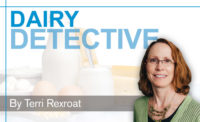U.S. dairy products and ingredients, which help foster health and wellness in people of all ages around the world, start with the nutritious milk dairy cows produce. Successful milk production depends not only on top-notch cow care, but also on clean air and water, healthy soil and vibrant ecosystems.
Right now, U.S. dairy is positioned to help global food and beverage manufacturers capitalize on the growing demand for more nutritious and flavorful products made from socially, environmentally and economically responsible sources.
The U.S. Dairy Export Council (USDEC) is promoting the efforts of the U.S. dairy community across the supply chain to showcase how and why the United States is a global leader in sustainability and social responsibility.
More with less
The United States leads the world by producing more with less — U.S. cows produce four times more milk than the average global cow.
Thanks to our dairy farmers’ careful management and adoption of innovative practices, producing a gallon of milk in 2017 involved 30% less water, 21% less land and a 19% smaller carbon footprint than it did in 2007. The carbon footprint of a glass of U.S. milk today is two-thirds smaller than it was 70 years ago and more than 50% less than the world average.
And U.S. dairy farmers and processers continue to innovate. Investing in technology and implementing advanced management
practices are increasing efficiency and further reducing U.S. dairy’s environmental impact by minimizing water and energy use and reducing greenhouse gas (GHG) emissions
and waste.
Addressing sustainability
In 2008, U.S. dairy farmers formed the Innovation Center for U.S. Dairy to assess, manage and continuously improve the environmental, social and economic sustainability of U.S. dairy from farm to table. As a result, life cycle assessments were completed to understand the environmental impacts of dairy production, processing and transportation.
In addition, the Innovation Center for U.S. Dairy has brought together more than 100 organizations from across the value chain to proactively and precompetitively address sustainability changes. As part of the Dairy Sustainability Alliance, members adopt and report on defined criteria for important areas such as animal care, environmental stewardship, food safety and traceability, and community contributions. We’re seeing results.
A 2019 report from the Food and Agriculture Organization of the United Nations and Global Dairy Platform says that North America is leading the world when it comes to efforts to reduce dairy GHG emissions. North America was the only region of seven studied where both emissions intensity and absolute emissions fell for the timeframe of the study (2005-2015), while overall milk production rose.
The next chapter
The worldwide sustainability goal today is to help feed a growing global population, expected to reach 9 billion by 2050, in the most environmentally responsible way possible. The U.S. dairy community is taking proactive steps to protect the planet — now and for future generations.
While U.S. dairy production accounts for only 2% of total U.S. GHG emissions, USDEC has joined other industry leaders to examine the viability of achieving net zero GHG emissions and a significant improvement in water quality coming from milk production on U.S. dairy farms.
Research is being done to see if this could be accomplished by providing the tools, expertise and financing to help our industry reach specific environmental outcomes. While net zero emissions may not be achieved everywhere, the goal is that the collective efforts of the entire value chain would lead to net zero GHG emissions for U.S. dairy in the future.
The U.S. dairy industry takes an open, transparent and science-based approach to measuring and communicating its progress. Visit USdairy.com or ThinkUSAdairy.org for more information about the U.S. Dairy Industry’s sustainability efforts.


